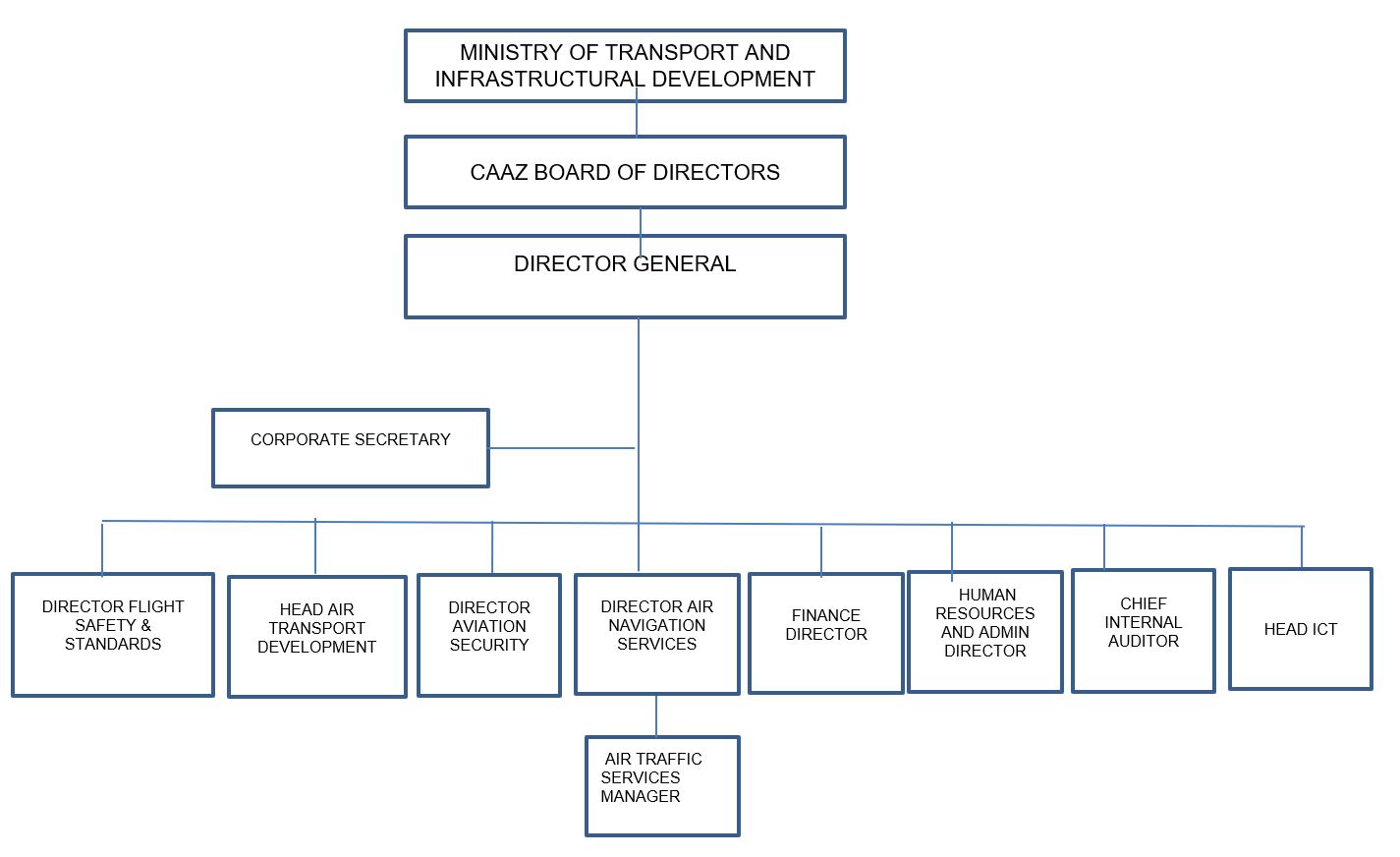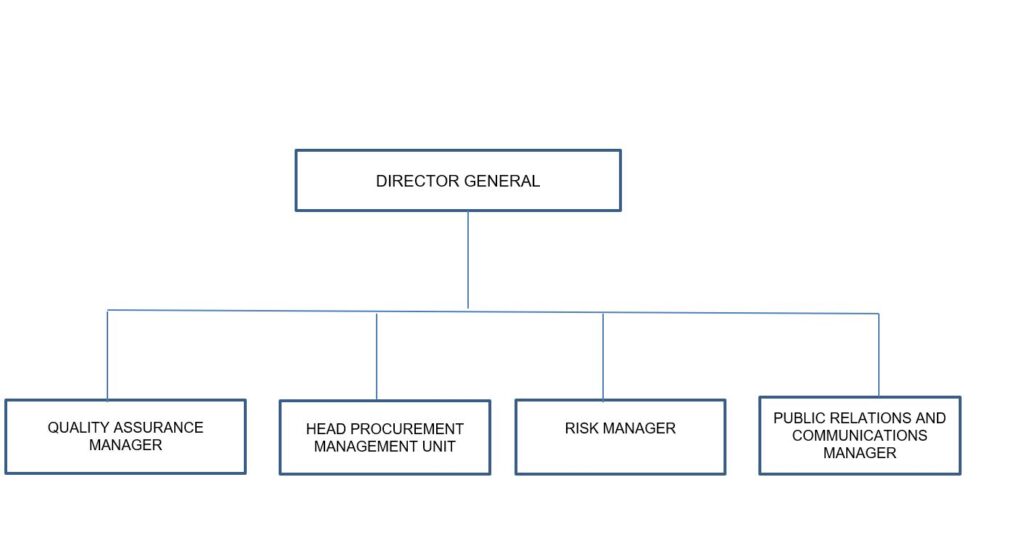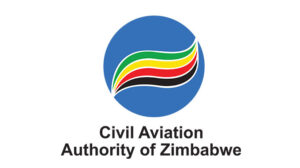The Civil Aviation Authority of Zimbabwe was established in 1999 by Statute, the Civil Aviation Act [Chapter 13:16], and took over the functions of the former Department of Civil Aviation. Following International Civil Aviation Organisation recommendations and best practices, the Authority was separated from Airport operations through the Civil Aviation Act.
Overall Functions
In terms of the Civil Aviation Act, the objects of CAAZ are:
- to promote and regulate civil aviation safety and security and provide related training;
- to develop air transport;
- to establish and maintain air navigation facilities and provide air navigation services and related training;
- to foster the development of the civil aviation industry and oversee its activities;
- to ensure compliance with the Act and the Chicago Convention and discharge in accordance with best practices and maximum efficiency the regulatory function assigned to it by the Act;
- to provide advice to Government on all matters related to domestic and international civil aviation.
Vision
To be a regional centre of excellence in civil aviation regulatory and air navigation services by the year 2030
Mission
To offer commercially viable civil aviation safety and security regulatory, air navigation services and related training
Mandate
- To promote the safe, regular and efficient use and development of air transport and provide air navigation services within Zimbabwe; and
- To advise the Government of Zimbabwe on all matters relating to domestic and international aviation.
Shared Values
- Continuous learning
- Teamwork
- Results Oriented
- Integrity (Ubuntu, Hunhu)
- Accountability
Management

Dr Engineer Elijah Chingosho
Director General

Mrs Betha Muzangaza
Corporate Secretary

Mr Percy Hove
Director Flight Safety and Standards

Mr Laxman Moyo
Director Aviation Security

Mr Blessing Ngwarai
Director Air Navigation and Technical Services

Mr Honest Murindagomo
Finance Director

Mr Silas Chichaya
Human Resources and Administration Director

Mr Albin Mashavira
Chief Internal Auditor

Mr Martin Rushizha
A/Head Air Transport and Development

Mrs Matilda Mushapaidzi
Air traffic Services Manager

Mrs Maggie Paradza
Information and Communications Technology Manager

Ms Loveness Sibanda
Quality Assurance Manager

Ms Firstme Vitori
PR and Communications Manager
Board Members

Captain Alois G Nyandoro
Board Chairman

Rtd. Dep Comm Gen Nonkosi M Ncube
Deputy Chairperson

Joshua Muhwati
Board Member

Dr. Tawanda Zinyama
Board Member

Prophetess Patricia Imbeah
Board Member

Dr Onai Muvingi
Board Member

Ms Eustinah Guta
Board Member
Departments
- Communication/Navigation & Surveillance
- Finance
- Flight Operations
- Human Resources and Admin
- ICT
- Internal Audit
Organisation Structure
Executive Management

Unit Heads

Get In Touch With Us
Contact Information
Head Office
- Level 3 International Terminal Building
- Robert Gabriel Mugabe International Airport
- P.Bag CY 7716, Causeway Harare
- Tel +263 242 585073-80
- Cell +263 772 132 715-30
Joshua Mqabuko Nkomo International Airport
- P. Bag G5082, Bulawayo
- Tel +263 (292) 296423-6
- Cell +263 772 132 743
Victoria Falls International Airport
- Bag 9, Victoria Falls
- Tel +263 (8328) 41575/6, 44428
- Tel +263 (772) 132 735/704
Kariba Airport
- P.O. Box 49, Kariba
- Tel +263 (61214) 6157/6405
- Cell +263 772 132 749
Masvingo Airport
- P.O. Box 149, Masvingo
- Cell +263 772 132 741
Hwange National Park Airport
- P.O. Box 91, Dete
- Cell +263 772 132 753/754
Buffalo Range Airport
- Box 12, Chiredzi
- Tel +263 (31231) 2819, 2444, 2720
- Cell +263 772 132 746
Charles Prince Airport
- P.O. Box MR 86, Malborough
- Cell +263 772 132 733/7344
Enquiries and Feedback
General Enquiries: pr@caaz.co.zw
Licencing Enquiries: licencing@caaz.co.zw
Flight Permit Enquiries: fltpermits@caaz.co.zw
Drone Enquiries: airworthiness@caaz.co.zw
Air Navigation Enquiries: ais@caaz.co.zw
Safety & Security
- Explosives and incendiary substances and other non-readily available components such as detonators, ignitors and secondary items such as incendiary material devices capable of being used to cause serious injury or threatening the safety of aircraft, including:
- ammunition;
- blasting caps;
- detonators and fuses;
- replica or imitation explosive devices;
- mines, grenades and other explosive military stores;
- pyrotechnics, including fireworks;
- smoke-generating canisters or cartridges; and
- dynamite, gunpowder and plastic explosives;
- Guns, firearms and other devices designed to cause serious injury or capable of being mistaken for such devices, including components of firearms and ammunition (improvised, single discharge weapons such as 3D printed items that may not be identifiable). Those include:
- firearms of all types, including pistols, revolvers, rifles and shotguns;
- toy guns, replicas and imitation firearms capable of being mistaken for real weapons;
- component parts of firearms, excluding telescopic sights;
- compressed air and carbon dioxide guns, including pistols, pellet guns, rifles and ball bearing guns;
- signal flare pistols and starter pistols; and
- electrical stun devices and improvised devices;
- Chemical substances, such as:
- disabling and incapacitating chemicals, gases and sprays, such as mace, pepper or capsicum sprays, acid sprays, animal repellent sprays, and tear gas;
- chemicals that, when mixed, are capable of creating a hazard through reaction (hypergolic reactions); and
- chemicals that cause any hazard to life or property whether or not classified as Dangerous Goods;
- Objects with sharp points or sharp edges, and devices that discharge projectiles capable of being used to cause serious injury, including:
- items designed for chopping, such as axes, hatchets and cleavers;
- ice axes and ice picks;
- razor blades and box cutters;
- bows, crossbows and arrows;
- harpoon guns and spear guns;
- slingshots and catapults;
- knives with blades of more than 6 cm;
- scissors with blades of more than 6 cm as measured from the fulcrum;
- martial arts equipment with sharp points or sharp edges; and
- swords and sabres;
- Workers’ tools capable of being used either to cause serious injury or to threaten the safety of aircraft, including:
- crowbars;
- drills and drill bits, including cordless portable power drills;
- tools with blades or shafts more than 6 cm capable of use as weapons, such as screwdrivers and chisels;
- saws, including cordless portable power saws;
- blowtorches; and
- bolt guns and nail guns;
- Blunt instruments capable of being used to cause serious injury when used to hit, including:
- baseball and softball bats;
- clubs and batons, such as billy clubs, blackjacks and night sticks; and
- martial arts equipment; and
- Explosive or incendiary substances or devices capable of being used to cause serious injury or threatening the safety of aircraft are prohibited in the hold of an aircraft for safety reasons, including the following (rules granting exemptions under defined circumstances may exist):
- with the approval of the operator, certain cartridges may be permitted for transport in hold baggage under conditions specified in Part 8, of the Technical Instructions for the Safe Transport of Dangerous Goods by Air (Doc 9284);
- blasting caps;
- detonators and fuses;
- mines, grenades and other explosive military stores;
- pyrotechnics, including fireworks;
- smoke-generating canisters or cartridges; and
- dynamite, gunpowder and plastic explosives
Shoes or footwear can be used to conceal prohibited items. Some shoes or footwear contain metallic elements which may trigger the Walkthrough Metal Detector alarm.
Any person who needs to access security restricted areas is subject to security search.
Zimbabwe does not have one stop security arrangements hence; transit and transfer passengers and their baggage are screened.
Liquids, Aerosols and Gels (LAGs) in containers over 100ml are not allowed in hand baggage unless you are carrying duty free sealed in a tamper-evident security bag, liquid medicines or special dietary products such as baby food.
Hoverboards are not allowed in the checked baggage because some of them have lithium battery components.
Do’s and Dont’s
- Check-in early and have all the necessary travel documents ready for inspection and give yourself time to clear airport screening processes.
- Make sure you have the correct boarding passes and travel documents to be presented if requested at the security check points and at boarding gates.
- Inform the security officers of your medical conditions, such as a pacemaker that might be affected by the screening process.
- Remove laptop computers, video cameras with cassettes, and film cameras from their carry-cases and place them in the tray provided.
- Declare any prohibited items and weapons to the screening staff at the security screening check point.
- Report any unusual behaviour or suspicious activity to airport staff.
- Do not leave your baggage unattended.
- Do not carry parcels for other persons without knowledge of what is inside.
- Do not make threats and comments about carrying weapons or explosives that may result in rejection to board the aircraft and prosecution.
- Do not pack sharp objects such as knives, scissors, corkscrews or knitting needles in your hand luggage.
- Do not carry any Liquids, Aerosols and Gels (LAGs) above 100 ml each in your hand luggage.
- Do not carry electronic gadgets with lithium batteries in your checked luggage such as laptops, mobile phones, power banks, hoverboards etc.
- Do not carry fire extinguisher in your carry-on or checked luggage.
Fees
Yes, online payments can be made directly on this website. Identify the service you need to make payment for and click on the “Pay Now” button.
General Infomation
Yes there are baggage wrapping facilities at R G Mugabe International Airport, J M Nkomo International Airport and Victoria Falls International Airport.
